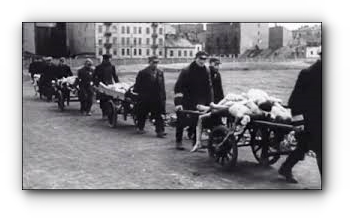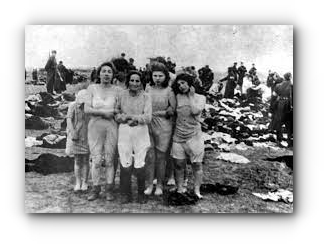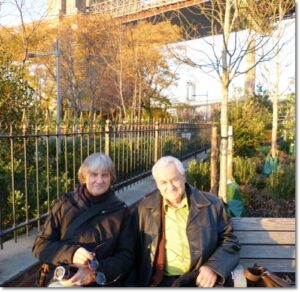MEMOIRS | OPINION | HISTORY | BELGIUM
◊
by Roland Binet (De Panne, Belgium)
◊
Until the age of seventeen I did not know at all that there were Jews. Following from that, I had moreover never heard anything of what happened to the Jews during World War II. My awakening came one evening in the fall of 1962.
I saw Frédéric Rossif’s documentary on the Warsaw Ghetto, Le Temps du Ghetto (‘The Time of the Ghetto’). I came away devastated, particularly shocked by the scenes of the starving children begging in the streets and by the “morning collection” of nude bodies picked up from the pavements and streets of Warsaw and transported by wheelbarrows and carts to a mass grave where the bodies were dumped without any respect. The images were at once revolting and unforgettable.

Screenshot from my ‘first shock’: Frédéric Rossif’s documentary on the Warsaw Ghetto, Le Temps du Ghetto (‘The Time of the Ghetto’)
A few years later, my boss Joachim Bruckner (in the Belgian export-import company where I worked, not knowing at first that he was Jewish), told me once that when he was very young (he had been born in 1927), he had been smuggled out from the Lvov (Lemberg, Lviv) Ghetto in a truck. He was lucky. The rest of his family was killed in Bełżec. This Jewish colleague, forty years my senior, originally from Romania and a Holocaust survivor, became a kind of father figure for me. He taught me much about manners, integrity, and culture, that would stand me in good stead for the rest of my years.
In 1973 I went to Israel for the first time and had the good fortune to be invited to Kibbutz Evron in the western Galilee. There I met Haika Grossman, a war heroine and member of the Knesset for the Mapam party. I discovered that she had worked as a courier for the anti-Nazi resistance during the war between the ghettos of Białystok, Lublin, Vilna and Warsaw. Ringelblum wrote about her in his diary (Sir Martin Gilbert mentions this in his masterly work on the Holocaust). Haika Grossman had written her recollections, The Underground Army – Fighters of the Bialystok Ghetto. She seemed to me a near miraculous apparition, live from the Holocaust, and a true living, seeable heroine.
Nine years later when I visited the Auschwitz and Birkenau death factories as well as the site of the former Warsaw Ghetto, I was able tour the death camps accompanied by five survivors of that hell on earth, all at the time resident in Belgium. I learned much from them. That same year, I had written a letter to Ana Novac, born in Romania, who earlier had published J’avais 14 ans à Auschwitz (‘I was 14 years old in Auschwitz’) and she had replied in a quite friendly tone.
One day, while my wife and I were in Paris, we rang her bell. She was at home and invited us to talk with her. We felt the dark weight of Auschwitz still inside her. She was living quite a solitary life and was somewhat bitter about what the world had become and the almost indifferent reactions to the history recounted in her books.
I felt sure I knew a lot about the Holocaust.
And it was in 2009, looking at the picture of the Eppstein family posing half-unclothed, a few minutes before their execution in Liepajā. The photograph was in the Muzejs Ebreji Latvijā, Riga’s Jewish museum. And I understood anew what a colossal ignoramus I had been all those four preceding decades. I had never read or heard anything about the Holocaust in the Baltic States or their environs in the east.

Eppstein family a few minutes before their execution in Liepajā (from the Jewish Museum in Riga, Latvia)
Later I met David Silberman, author of И Ты Это Видел (‘And You Saw It’). David had carried out the huge work of secretly collecting testimony from Jewish survivors of the Holocaust in Latvia during the 1960s. Thatg was a time when such an activity might have sufficed to lure the KGB into his home at night and land him in the Gulag. Luckily, his family had succeeded in fleeing to the Soviet Union upon the Nazi invasion of 1941. Otherwise they might have been some of the eight hundred persons executed in Preiļi between July 28 and August 9, 1941, primarily by self-defense (sic.) Latvian forces (see in Extermination of the Jews in Latvia 1941-1945, ed. Menachem Barkahan).
In 2013, thanks to David Silberman I was invited to the annual Yizkor (commemoration event) of the Jewish survivors of Latvia, held on Nov. 17 in a synagogue on the eastern side of Central Park in New York City. I was invited to tell the assembled, how I, an ordinary goy, had taken an interest in the destruction of the Jews of Latvia.

With David Silberman in New York
There I met quite remarkable persons, many also survivors of the horrofic slaughter in Latvia, among them Professor George Schwab, originally from Liepajā, Ivar Brod from Riga, a mere child during the war, and Gerta Feigin whose parents were arrested by the NKVD on June 14, 1941, and others. Later that year, I visited Rumbula in Latvia, site of the murder of 26,000 victims in just two days, and Ponár (Ponary, Paneriai) in Lithuania, where 100,000 people were murdered, about 70,000 of whom were Vilna area Jewry.
My actual knowledge of what happened to the Jews in the western as well as in the eastern parts of Europe is a series of fortuitous milestones in my lifetime education. A documentary I saw one evening about the Warsaw Ghetto. A man who answered an advertisement I had put in a newspaper and who happened to be a Jew and who hired me. A book in Russian about the Holocaust in Latvia. Thanks to Dr. Efraim Zuroff of the Wiesenthal Center in Jerusalem I came in contact with Prof. Dovid Katz and his web journal Defending History (called Holocaust in the Baltics during its first year, 2009-2010). In Nov. 2010 he published my first opinion piece on the Holocaust in Latvia.
Efraim Zuroff and Dovid Katz, both Brooklyn, New York born and bred, have spent many years fighting against state-sponsored history revisionism, renewed antisemitism in some of the formerly communist Eastern European countries, and the East European cult of the macabre that glorifies as “state heroes” former Nazi collaborators. One can see this in the Baltic states, Croatia, western Ukraine, and elsewhere. They deserve recognition for their tireless and uncompromising struggle to have the truth and only the truth recorded in the historic record of the civilized world concerning the fate of East European Jewry.
It is a cliché to note how the decades fly by. It is now over sixty years that I have been reading about the Holocaust (and seeing documentaries) and I am still constantly discovering facts and aspects hitherto unknown to me.
Yet, around me in Belgium, I have the feeling that less and less people are interested or knowledgeable about the destruction of a major minority population of very own Europe, and I am sometimes pessimistic about wider memory preservation of what happened in our midst. Yet, I never regretted having immersed myself in these matters or continuing to do so, even if I have spent thousands of hours doing it. I owe it to the millions of victims, as a human being. It is a matter of decency. And, like every lifetime journey of growth and learning, it does bring great benefit to oneself as a citizen of our planet and one who believes in human growth at every age of our lives. I remain optimistic that it will continue to do so for some inspired and enlightened people, here in Europe, and around the world, also in the years and generations to come.
